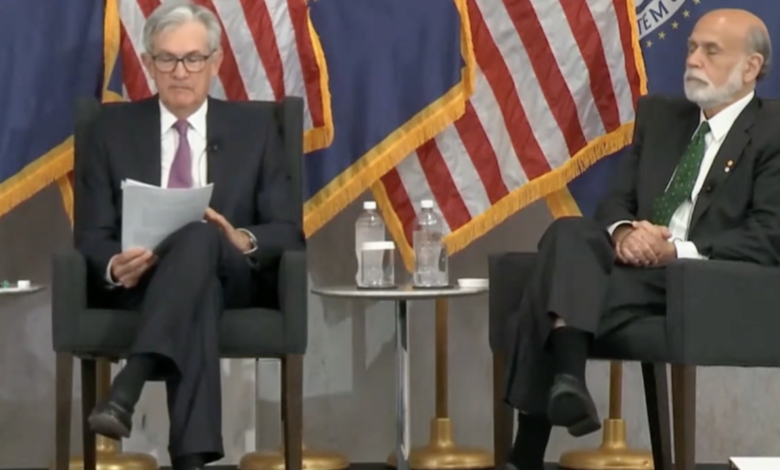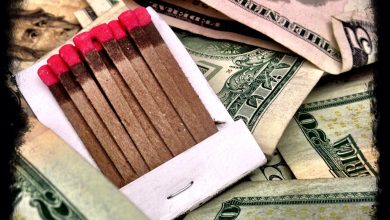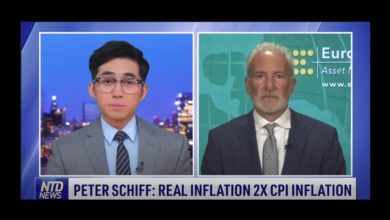Bernanke and Powell: A Lot of Finger-Pointing but No Self-Reflection

Federal Reserve Chairman Jerome Powell and former chair Ben Bernanke recently fielded questions together at the annual Thomas Laubach Research Conference put on by the central bank. They engaged in a lot of finger-pointing but didn’t offer a hint of self-reflection as they discussed inflation and the state of the economy.
Powell and Bernanke both garner immense respect. People just assume they must have a deep understanding of economics and monetary policy to get a job heading up the Fed. But in reality, the reason they rose to that position has more to do with political connections than economic competency.
You can also always count on people like Powell and Bernanke to toe the establishment line. They get the job because the people who appoint them know that they will espouse the things they want them to espouse. You can count on them to extol the virtues of big government, government spending, and interventional central banking. And of course, they are also going to lie about inflation. Anybody who tells the truth about inflation and its roots in central bank monetary policy doesn’t have a prayer of landing the job as Fed chair.
Bernanke
Bernanke was asked why the Fed didn’t model the scenario that led to the most recent bank failures. He said that they simply didn’t expect a situation where the economy weakens and assets such as Treasuries and mortgage-backed securities go down in value. Typically, they gain value during economic turmoil.
What did the central bankers miss?
Stagflation.
Mainstream economists simply can’t fathom a world with rising prices in a contracting economy.
They failed to account for the fact that inflation puts downward pressure on Treasuries. That’s because the present values and income streams of these assets are eroded due to inflation. And as the Fed hikes rates to fight inflation, that puts even more downward pressure on the price of lower-yielding long-term instruments, even as it slows down economic activity.
And it’s clear they still don’t really understand this dynamic because they seem rather perplexed about what happened, and they continue to insist that the banking system is sound when in reality, this dynamic has impacted hundreds of banks.
Bernanke was also asked about the cause of high inflation in the 1970s. He offered two reasons.
- Oil price shocks
- Consumer expectations
In other words, consumers began to anticipate rising prices. This led to demands for higher wages and more price hikes, creating an inflationary spiral.
Nowhere in Bernanke’s discussion on 1970s inflation did he mention going off the gold standard, government spending for the Great Society and the Vietnam War, and all the money created by the Federal Reserve to support the borrowing and spending.
In fact, the price shocks and the inflation expectations were the results of Fed money creation and government spending. If Bernanke doesn’t understand why we had inflation in the 1970s, why would anybody expect him to understand inflation today?
Of course, he may well understand exactly why we had inflation in the 1970s but just won’t say it out loud. Either way, it explains how he managed to become the Federal Reserve chair. He would have never had a seat at the table if he was willing to be truthful about inflation.
Bernanke also complained about frequent revisions in government data. He said that made it very difficult to formulate policy. The FOMC would make a decision based on data and the next thing you know, there were big revisions.
But why does the Fed depend so much on numbers in the first place? They shouldn’t need numbers to make policy. They should understand the bigger picture and the implications of what they’re doing. When interest rates are held at 0% for years and the balance sheet is exploding, Fed officials shouldn’t need CPI data to know they have an inflation problem. By the time the inflation problem shows up in the numbers, it’s too late.
Powell
Jerome Powell also had some things to say during this Q&A session.
He seemed to put the possibility of a pause back on the table.
The financial stability tools helped to calm conditions in the banking sector. Developments there, on the other hand, are contributing to tighter credit conditions and are likely to weigh on economic growth, hiring and inflation. So as a result, our policy rate may not need to rise as much as it would have otherwise to achieve our goals.”
Powell thinks tighter credit will put more downward pressure on the economy and that will lower inflationary pressure. But as I’ve discussed, the disconnect is Powell and pretty much everybody in the mainstream thinks the downward pressure on the economy will only cause a short shallow recession. Powell even recently held out hope for a “soft landing.” But in reality, there is no reason to think the recession will be mild.
Powell also said the stance of monetary policy is now restrictive and there is uncertainty about the lagging effects of the tightening so far.
In other words, a 5% funds rate is “tight.”
But it isn’t. It’s still easy.
Monetary policy is certainly tighter than it was, but price inflation, even based on government numbers, remains at 5%. That means real rates are zero. Zero isn’t restrictive.
When interest rates were 20% in 1981 under Paul Volker, CPI was in the 13% range. And that was a much more honest 13%. If you used today’s CPI formula in the 1970s, it would probably be in the 6 or 7 percent range. In other words, interest rates were nearly triple the CPI. In order to get to where we were back then today, the Fed would need to raise rates to around 15%.
Powell also talked about the fact the global supply chains kept inflation at bay prior to the pandemic. In a sense, he got that right. But not completely.
The ability to import cheap goods from China did keep prices low. But it didn’t keep inflation low. Inflation was there because the Fed was expanding the money supply with its easy money policies. Cheap imports helped paper over price inflation. It hid the effects.
Think of it this way. If the Fed hadn’t been creating a bunch of money and we still enjoyed cheap imports from China, prices might have dropped by 5% instead of rising by 2%. People didn’t see the negative impacts of the Fed’s inflationary policy.
Of course, mainstream economists claim falling prices are a problem. They’re not. If things get less expensive, people have more money to spend on other things. Aggregate spending goes up, whereas today, aggregate spending is going down. People are spending more, but they are actually getting less.
Regardless, Powell admitted that the cover isn’t there anymore. Now, when the Fed creates inflation, we’ll all know it. We’ll see it because it won’t be disguised by global supply chains.
Powell was asked about the cause of today’s price inflation. He blamed supply shocks and a tight labor market. In other words, just like Bernanke was wrong about inflation in the 1970s, Powell was wrong about inflation today.
Powell was sitting right next to the guy that launched the first round of quantitative easing. And of course, Powell was responsible for QE infinity during the pandemic. These two men were responsible for creating trillions of dollars out of thin air. That is, by definition, inflation. There was no hint of self-awareness from Powell or Bernanke.
They are always pointing fingers. They are never accepting responsibility.
Call 1-888-GOLD-160 and speak with a Precious Metals Specialist today!
Buka akaun dagangan patuh syariah anda di Weltrade.
Source link







